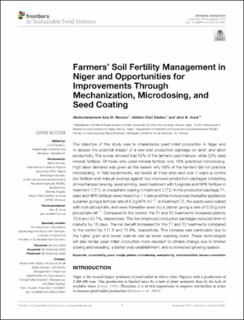| dc.contributor.author | Nourou, Abdourahamane Issa M. | |
| dc.contributor.author | Saidou, Addam Kiari | |
| dc.contributor.author | Aune, Jens Bernt | |
| dc.date.accessioned | 2020-12-04T13:54:11Z | |
| dc.date.available | 2020-12-04T13:54:11Z | |
| dc.date.created | 2020-11-30T21:21:17Z | |
| dc.date.issued | 2020 | |
| dc.identifier.issn | 2571-581X | |
| dc.identifier.uri | https://hdl.handle.net/11250/2712004 | |
| dc.description.abstract | The objective of this study was to characterize pearl millet production in Niger and to assess the potential impact of a low-cost production package on land- and labor productivity. The survey showed that 62% of the farmers used manure, while 22% used mineral fertilizer. Of those who used mineral fertilizer only 18% practiced microdosing. High labor demand was given as the reason why 89% of the farmers did not practice microdosing. In field experiments, we tested at three sites and over 2 years a control (no fertilizer and manual sowing) against two improved production packages consisting of mechanized sowing, seed priming, seed treatment with fungicide and NPK fertilizer in treatment 1 (T1), or phosphate coating in treatment 2 (T2). In the production package T1, seed and NPK fertilizer were mixed in a 1:1 ratio and this mixture was thereafter applied by a planter giving a fertilizer rate of 0.3 g NPK hill−1. In treatment T2, the seeds were coated with rock phosphate, and were thereafter sown by a planter giving a rate of 0.35 g rock phosphate hill−1. Compared to the control, the T1 and T2 treatments increased yield by 70.9 and 42.7%, respectively. The two improved production packages reduced time to maturity by 10 days. The net benefit increased for the T1 and T2 treatments compared to the control by 111.8 and 72.8%, respectively. This increase was particularly due to the higher grain and stover yield as well as lower weeding costs. These technologies will also render pearl millet production more resistant to climate change due to timelier sowing and weeding, a better crop establishment, and a shortened growing season. | en_US |
| dc.language.iso | eng | en_US |
| dc.relation.uri | https://www.frontiersin.org/articles/10.3389/fsufs.2020.570561/full | |
| dc.rights | Attribution-NonCommercial-NoDerivatives 4.0 Internasjonal | * |
| dc.rights.uri | http://creativecommons.org/licenses/by-nc-nd/4.0/deed.no | * |
| dc.title | Farmers' Soil Fertility Management in Niger and Opportunities for Improvements Through Mechanization, Microdosing, and Seed Coating | en_US |
| dc.type | Peer reviewed | en_US |
| dc.type | Journal article | en_US |
| dc.description.version | publishedVersion | en_US |
| dc.source.volume | 4 | en_US |
| dc.source.journal | Frontiers in Sustainable Food Systems | en_US |
| dc.identifier.doi | 10.3389/fsufs.2020.570561 | |
| dc.identifier.cristin | 1854534 | |
| dc.relation.project | Utenriksdepartementet: The Norwegian Ministry of Foreign Affairs | en_US |
| cristin.ispublished | true | |
| cristin.fulltext | original | |
| cristin.qualitycode | 1 | |

